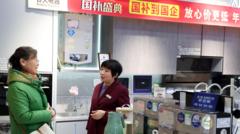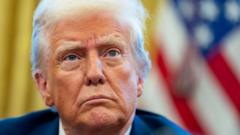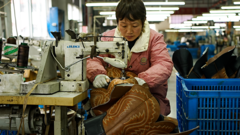China is expanding its trade-in scheme for household appliances as part of broader efforts to stimulate its struggling economy, facing low consumer demand and a housing market crisis.
China's Appliance Trade-In Scheme Aims to Revitalize Economy

China's Appliance Trade-In Scheme Aims to Revitalize Economy
China introduces new incentives for consumers to boost consumption through appliance trade-ins.
China's government has expanded its consumer goods trade-in program aimed at invigorating the economy by allowing citizens to trade old appliances for discounts of up to 20% on new purchases. The newly included items comprise microwave ovens, dishwashers, rice cookers, and water purifiers, enhancing the previously established list that involved televisions, smartphones, tablets, smartwatches, and electric vehicles. This initiative adds to the government's ongoing attempts to tackle issues such as weak consumer enthusiasm and a deepening property sector crisis.
According to reports, an allocation of 81 billion yuan (approximately £8.9 billion; $11 billion) has been designated for the trade-in scheme for this year. As highlighted by China's top economic planning authority, the program, initiated in March, has shown "visible effects" in the market. The Ministry of Commerce noted an uptick in the sales of larger consumer goods, particularly home appliances and automobiles.
Despite these promising signs, some economists express skepticism regarding the program's potential to significantly influence overall consumer spending. Harry Murphy Cruise, head of China economics at Moody's Analytics, remarked, "The approach has had mixed success so far," indicating that while certain goods have seen increased sales, comprehensive consumer expenditure has not necessarily risen in tandem.
Amid growing challenges for Chinese exporters, recent months have seen intensified government efforts to bolster the domestic economy. A crucial meeting of China's leaders in December underscored the necessity for "vigorous" actions to increase consumer spending. This follows a period of heightened tension regarding trade, particularly with impending tariffs on Chinese products mentioned by President-elect Donald Trump, who is set to return to the White House soon.
Next week, China is expected to reveal its economic growth estimates for 2024, which the government currently projects to be around 5%.
According to reports, an allocation of 81 billion yuan (approximately £8.9 billion; $11 billion) has been designated for the trade-in scheme for this year. As highlighted by China's top economic planning authority, the program, initiated in March, has shown "visible effects" in the market. The Ministry of Commerce noted an uptick in the sales of larger consumer goods, particularly home appliances and automobiles.
Despite these promising signs, some economists express skepticism regarding the program's potential to significantly influence overall consumer spending. Harry Murphy Cruise, head of China economics at Moody's Analytics, remarked, "The approach has had mixed success so far," indicating that while certain goods have seen increased sales, comprehensive consumer expenditure has not necessarily risen in tandem.
Amid growing challenges for Chinese exporters, recent months have seen intensified government efforts to bolster the domestic economy. A crucial meeting of China's leaders in December underscored the necessity for "vigorous" actions to increase consumer spending. This follows a period of heightened tension regarding trade, particularly with impending tariffs on Chinese products mentioned by President-elect Donald Trump, who is set to return to the White House soon.
Next week, China is expected to reveal its economic growth estimates for 2024, which the government currently projects to be around 5%.






















